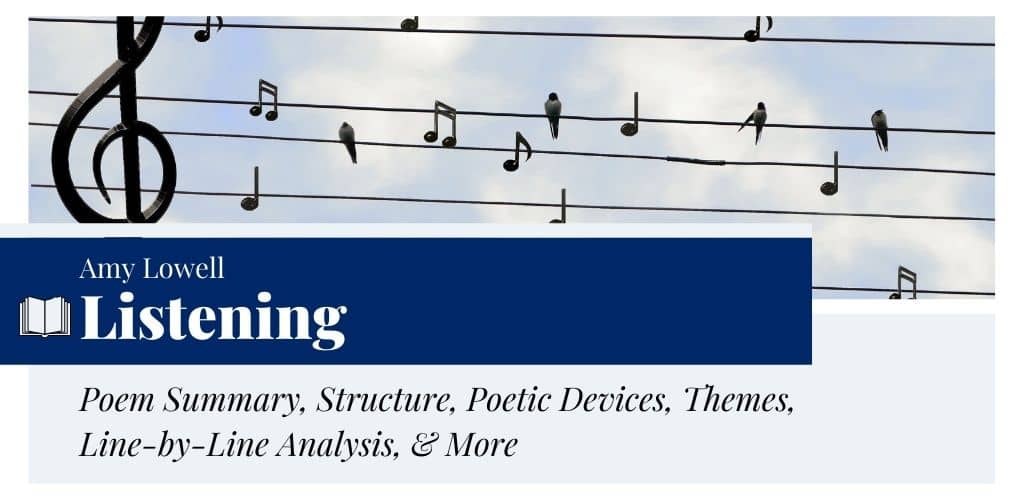Listening by Amy Lowell
“Listening” by Amy Lowell (1874-1925) is a lyrical sonnet where the poet confesses her love for someone using images from nature and music — both of which add and compound this piece into an emotional and harmonious work. In this poem, a speaker describes the connection between the soul’s music and nature’s eternal symphony. Throughout our lives, we compose several musical notes, but the spirit’s eternal music remains constant. These variations rather enhance its musicality as Spring and Autumn do to nature.
- Read the full text of “Listening” below:
Listening by Amy Lowell ’T is you that are the music, not your song. The song is but a door which, opening wide, Lets forth the pent-up melody inside, Your spirit’s harmony, which clear and strong Sing but of you. Throughout your whole life long Your songs, your thoughts, your doings, each divide This perfect beauty; waves within a tide, Or single notes amid a glorious throng. The song of earth has many different chords; Ocean has many moods and many tones Yet always ocean. In the damp Spring woods The painted trillium smiles, while crisp pine cones Autumn alone can ripen. So is this One music with a thousand cadences.

Summary
In “Listening,” Lowell is literally “listening” to the beauty of a person she is writing for. The person in the poem is hinted at as being a musician, but rather than her songs, the poet falls in love with them instead. She goes on to compare the different shades of the person to that of the ocean and woods. No matter what mood the ocean has, its brilliance is always eternal and prevailing.
Form, Rhyme Scheme, & Meter
“Listening” is a sonnet as it has 14 lines and is written in iambic pentameter. The rhyme scheme of the poem is ABBAABBA CDCDEE. From the rhyme scheme, it becomes clear that the poem closely resembles the Petrarchan sonnet form. It is divided into two sections: an octave and a sestet. Besides, the text ends with a rhyming couplet. However, Lowell does not separate the octave from the sestet. Regarding the meter, each line consists of five iambs. Let us have a look at the metrical scheme of the first few lines:
’T is you/ that are/ the mu/-sic, not/ your song.
The song/ is but/ a door/ which, open/-ing wide,
Lets forth/ the pent/-up me/-lo-dy/ in-side,
Your spi/-rit’s har/-mo-ny,/ which clear/ and strong
Poetic Devices
- Personification: Giving human characteristics to nonhuman things. For example, “Ocean has many moods,” “Your spirit’s harmony, which clear and strong/ Sing but of you,” etc.
- Alliteration: Production of similar sounds in neighboring words. For example, “waves within,” “life long,” “many moods,” etc.
- Apostrophe: It occurs when a speaker addresses someone who is not present in the poem. For example, “’T is you that are the music, not your song.”
- Imagery: The poet uses strong and descriptive words to create an everlasting image. For example, “Your spirit’s harmony, which clear and strong,” “The painted trillium smiles, while crisp pine cones/ Autumn alone can ripen,” etc.
- Metaphor: The comparison of two, unlike things, is a metaphor. For example, in “’T is you that are the music, not your song,” the speaker compares her beloved to “music.” In the next line, she compares the “song” to the “door” to the spirit.
- Symbolism: Trillium is a three-petaled flower that signifies spiritual embodiment, elegance, and grace. In the poem, the poet uses it as a symbol of nature’s elegance.
- Enjambement: Where the poet continues one sentence in another line. For example, “Your spirit’s harmony, which clear and strong/ Sing but of you.”
Themes
The main theme of “Listening” is the symmetry between the song of the spirit and that of nature. Throughout the poem, Lowell uses vivid imagery to describe the spiritual beauty of the person. She links back her metaphors to nature and music to illustrate the harmony of the person’s soul. For example, “This perfect beauty; waves within a tide,/ Or single notes amid a glorious throng.”
She describes that beauty comes in different forms, that the ocean has “moods,” and the song of the earth has different “chords.” At the end of the day, they are still beautiful in their own right, as is the soul of the musician she is describing. She says, “In the damp Spring woods/ The painted trillium smiles, while crisp pine cones/ Autumn alone can ripen. So is this/ One music with a thousand cadences.” These lines paint a picture of nature in all its harmony to put a name to the beauty the poet witnesses.
Line-by-Line Analysis & Explanation
Line 1-5
’T is you that are the music, not your song.
The song is but a door which, opening wide,
Lets forth the pent-up melody inside,
Your spirit’s harmony, which clear and strong
Sing but of you. Throughout your whole life long
In the first few lines of the sonnet, Lowell uses a conversational tone to introduce a person. That person seemingly writes or sings songs. According to the speaker, the song is just a door that releases the melody, which is suppressed inside the human soul. She goes on to say that the person’s spirit is in perfect musical harmony. It “sings” of the person herself. Lowell admires this “clear” and “strong” melody of the soul. She associates this music with the beauty of the person.
Lines 6-8
Your songs, your thoughts, your doings, each divide
This perfect beauty; waves within a tide,
Or single notes amid a glorious throng.
Lowell continues from “Throughout your life long” and says that the person’s songs, thoughts, and actions are all small parts of the collective beauty of their being. They are like “waves within a tide,” which are many but all in harmony. She also uses the metaphor of “single notes,” which hint at the person’s actions, thoughts, and music. These are all invaluable and add more beauty to the soul, described as “a glorious throng.”
Lines 9-11
The song of earth has many different chords;
Ocean has many moods and many tones
Yet always ocean. In the damp Spring woods
In these lines of “Listening,” Lowell elaborates on the last few lines. She says that like the person, the earth has “many different chords,” and the ocean has many different “tones” and “moods.” However, despite all this, the ocean is still the same as the person’s soul. The soul is still beautiful despite the different “notes” in it.
Lines 12-14
The painted trillium smiles, while crisp pine cones
Autumn alone can ripen. So is this
One music with a thousand cadences.
Lowell shifts the tone in the last few lines of “Listening.” She paints a picture of “damp Spring woods.” Besides, she uses color to enhance the image of the “painted trillium” and “crisp pine cones.” The phrase “Autumn alone can ripen” contains a personification. It describes how the pine cones become ripe in Autumn.
The poet ends the sonnet by saying that the person’s soul is like “one music” with a thousand cadences — a tapestry of a thousand melodies strung together in perfect harmony. This divine harmony in humankind and nature is glorified in Lowell’s sonnet “Listening.”
Historical Context
Amy Lowell was born on February 9, 1874, in Boston, Massachusetts. She is a well-known poet who brought imagism to the attention of American readers. The imagist school of writing favored picturesque language. She is also known for her unique feminist style of writing that she later adapted. Though she was famous for her vers libre, she also penned some beautiful sonnets like “Listening.”
Questions & Answers
Amy Lowell’s “Listening” is about the poet’s deep admiration for the harmonious music inside the human soul.
The poem’s subject is seemingly a musician; however, the poet uses musical words to describe the beauty of her soul. Thus, the poet is “listening” to the implicit music of her soul and not just the songs she sings.
The central theme of the poem is the musicality of the soul and nature.
The poetic devices used in the poem are alliteration, metaphor, imagery, symbolism, etc.
“Listening” is a sonnet composed of iambic pentameter.
Similar Poems about Spirituality and Nature
- “The Arrow and the Song” by Henry Wadsworth Longfellow — This piece celebrates the importance of compassion over hatred through the metaphors of an “arrow” and a “song.”
- “Deep in the Quiet Wood” by James Weldon Johnson — This piece is about nature’s eternal symphony that soothes one’s weary spirit and reinvigorates the broken pieces of the soul.
- “Have you got a brook in your little heart” by Emily Dickinson — This poem is about human life and soul presented through the symbol of a brook running inside one’s heart.
- “The Nightingale” by Sir Philip Sidney — This piece is about the nightingale’s song that enhances the lovelorn speaker’s heartache.
External Resources
- About Amy Lowell — Learn about the poet’s life and career.
- Poet Profile & Poems of Amy Lowell — Explore the poet’s profile and her other poems.
- Read Amy Lowell’s first poem — She wrote this piece at the age of nine.
- Poems of Amy Lowell — Read some of her best-known poems.
- Check out “The Poetry of Amy Lowell” — Explore this collection consisting of Amy Lowell’s best-loved poems.

